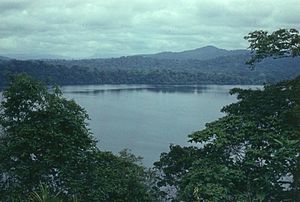Barombi Mbo
| Barombi Mbo | ||
|---|---|---|

|
||
| The Barombi Mbo. | ||
| Geographical location | Region Sud-Ouest , Cameroon | |
| Drain | → Kumba → Mongoose → Wouri → Cameroon Estuary → Bonny Bay | |
| Location close to the shore | Kumba | |
| Data | ||
| Coordinates | 4 ° 40 ′ 0 ″ N , 9 ° 24 ′ 0 ″ E | |
|
|
||
| Altitude above sea level | 280 m | |
| surface | 5 km² | |
| length | 2.5 km | |
| Maximum depth | 111 m | |
|
particularities |
||
The Barombi Mbo (formerly also Elephant Lake ) is a crater lake in the Sud-Ouest region of Cameroon .
location
It was already measured in 1912 by the German geographer Kurt Hassert . With a diameter of 2.5 km, the almost round lake is the largest of the crater lakes in West Cameroon . It is located at about 280 meters above sea level between the Rumpi and Bakossi mountains , about 2.5 kilometers northwest of Kumba . It is located in an extinct stratovolcano. The inside of the crater wall is almost vertical and reaches 90 m deep. Its maximum depth is 111 meters.
The lake is only fed by rainwater and has a drain at the south end that leads into the Mungo river system . A small dam was built at the outflow so that the water level fluctuations of around one meter that were typical in the past are now missing. Its banks are wooded. There are rocky and sandy areas as well as places that are characterized by collections of fallen leaves and trees that have fallen into the water. The lake is overgrown with aquatic plants to a depth of four meters. Below 40 meters, the lake is oxygen-free. The underwater visibility is very good and is around ten meters.
It is not to be confused with the Barombi Koto, 25 km southwest , which drains into the Meme River .
Ecology and use
The water quality is considered to be very good and, with a minor treatment, is already drinking water quality. The municipal water supply of Kumba is fed by the lake.
The lake is located in the settlement area of the Oroko people . There is only a small village on the west bank of the lake, as the lake's waters are considered bewitched. The lake is only used for fishing by the residents of the nearby Barombi village. Overfishing, the clearing of the banks and the input of chemicals from agriculture endanger the flora and fauna of the lake.
fauna

A total of 15 fish species live in the lake, crabs of the genera Caridina , Macrobrachium and Potamon as well as sponges of the genus Corvospongilla .
Of the fish, eleven species are cichlids . All are endemic , which means they only live here. Three cichlid belong to the genus Sarotherodon , including the phytoplankton - filter feeders Sarotherodon linnellii and Sarotherodon lohbergeri that eats mainly filamentous algae and diatoms , rhizopoda , rotifers and detritus , it receives with the algae and Sarotherodon steinbachi , the sand by chewing. The others belong to the endemic genera Myaka (plankton eater), Konia (mosquito larva-eating deep-water dweller), Pungu (sponge-eating shallow-water dweller ) and Stomatepia (predatory fish), which specialize in different habitats and diets . All species of cichlids are mouthbrooders . They are likely to have arisen through sympatric speciation from one or only a few predecessor species . The tilapia Sarotherodon galilaeus is widespread in the surrounding river systems and is a possible predecessor species.
In addition to the cichlids, the lake is home to two species of predatory catfish ( Clarias ), the barbel Labeobarbus batesii and a splendid carrot ( Aphyosemion oeseri ).
history
At the time of the German colony of Cameroon , the Barombi Mbo was also known as the Elephant Lake. At that time, elephants were still often to be found on the lakeshore , but they became rarer shortly after 1900. In 1888 the German researchers and colonialists Eugen Zintgraff and Karl Zeuner founded the Barombi station on the south- eastern shore of the lake . From here expeditions were sent into the hinterland of Cameroon. After the station was closed for a few years, it was reopened in 1895 under the name Johann-Albrechts-Höhe .
The German author Eginhard von Barfus wrote the youth novel Am Elefantensee , published in 1896 , in which the lake is the focus of an adventure story.
See also
Individual evidence
- ↑ a b c d Uli Schiewen: Diversity in the smallest of spaces - Cameroon's Southwest Province. in DATZ, 2/2003, ISSN 1616-3222
- ↑ a b Uli Schiewen: The cichlids of the Cameroon crater lakes. in DATZ , 3/92, ISSN 1616-3222
- ↑ Delegation trip of board members of the SLV NRW to visit schools and other educational institutions in the Anglophone provinces in Cameroon from October 18 to November 1, 2003 (PDF document; 960 kB) (German)
- ↑ Sarotherodon linnellii on Fishbase.org (English)
- ↑ Sarotherodon lohbergeri on Fishbase.org (English)
- ↑ Sarotherodon steinbachi on Fishbase.org (English)
- ^ Rochus Schmidt: Germany's colonies . Volume 2, Berlin: Verlag des Verein der Buchfreunde Schall & Grund, 1898, p. 126.
- ↑ Entry "Elefantensee" in the colonial dictionary
- ↑ Abenteuerroman.info: At the Elephant Lake
swell
- Siegfried Passarge : Elefantensee , in: Deutsches Kolonial-Lexikon , Volume 1, Leipzig 1920, pp. 554f.


